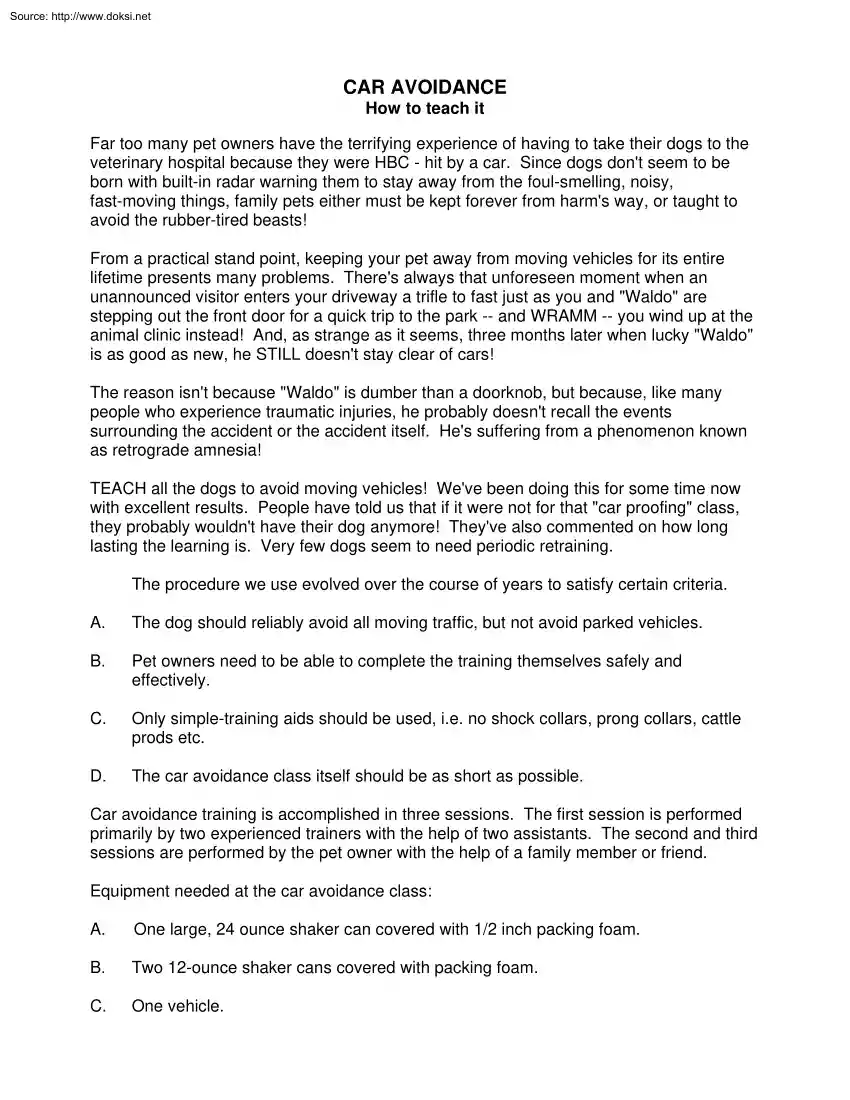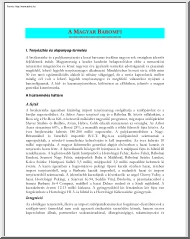Datasheet
Year, pagecount:2009, 3 page(s)
Language:English
Downloads:4
Uploaded:November 26, 2018
Size:459 KB
Institution:
-
Comments:
Attachment:-
Download in PDF:Please log in!
Comments
No comments yet. You can be the first!Most popular documents in this category
Content extract
Source: http://www.doksinet CAR AVOIDANCE How to teach it Far too many pet owners have the terrifying experience of having to take their dogs to the veterinary hospital because they were HBC - hit by a car. Since dogs dont seem to be born with built-in radar warning them to stay away from the foul-smelling, noisy, fast-moving things, family pets either must be kept forever from harms way, or taught to avoid the rubber-tired beasts! From a practical stand point, keeping your pet away from moving vehicles for its entire lifetime presents many problems. Theres always that unforeseen moment when an unannounced visitor enters your driveway a trifle to fast just as you and "Waldo" are stepping out the front door for a quick trip to the park -- and WRAMM -- you wind up at the animal clinic instead! And, as strange as it seems, three months later when lucky "Waldo" is as good as new, he STILL doesnt stay clear of cars! The reason isnt because "Waldo" is dumber
than a doorknob, but because, like many people who experience traumatic injuries, he probably doesnt recall the events surrounding the accident or the accident itself. Hes suffering from a phenomenon known as retrograde amnesia! TEACH all the dogs to avoid moving vehicles! Weve been doing this for some time now with excellent results. People have told us that if it were not for that "car proofing" class, they probably wouldnt have their dog anymore! Theyve also commented on how long lasting the learning is. Very few dogs seem to need periodic retraining The procedure we use evolved over the course of years to satisfy certain criteria. A. The dog should reliably avoid all moving traffic, but not avoid parked vehicles. B. Pet owners need to be able to complete the training themselves safely and effectively. C. Only simple-training aids should be used, i.e no shock collars, prong collars, cattle prods etc. D. The car avoidance class itself should be as short as possible.
Car avoidance training is accomplished in three sessions. The first session is performed primarily by two experienced trainers with the help of two assistants. The second and third sessions are performed by the pet owner with the help of a family member or friend. Equipment needed at the car avoidance class: A. One large, 24 ounce shaker can covered with 1/2 inch packing foam. B. Two 12-ounce shaker cans covered with packing foam. C. One vehicle. Source: http://www.doksinet D. Paved area secured from all other traffic. E. Two highly visible markers such as traffic pylons, brightly colored plastic buckets, etc. The car avoidance class is an optional meeting since it involves convincing the dogs that they were almost run over by a car! Because the staged accident needs to be as realistic as possible, the dogs will be stressed to varying degrees depending upon the individual temperamental differences and training variables. Owners will also need to do two follow-up sessions,
one the day after class and the other two days later. They will need to enlist the aid of a helper who can drive for these two staged events. One session should be done on the street or driveway in front of your home, and the second needs to be done away from their neighborhood at a location unfamiliar to the dog. Two bright orange traffic pylons are used to cue the driver as to when to begin applying the brakes and where the truck should actually stop. The pylons are placed on the pavement about fourteen feet apart on the driver side of the car. When you first arrive, we have you leave your dogs in your cars well away from the "accident" site. We then explain and demonstrate the procedure without a dog We begin by taking the first dog on leash and pretend to cross the "street," while the truck approaches from my left. As the driver approaches the first pylon, she slams on the brakes, while I pretend to be hit by the truck. I do this by sharply striking the front
fender of the pickup with my gloved hand as the truck comes to a stop. Simultaneously, my assistant, who is standing off to my right side, about ten feet to my rear, throws the large, padded shaker can at the front truck tire. At the same time, the assistant, who is riding in the front passenger seat of the pickup, throws one of the smaller, twelve ounce cans AT THE DOG. They both toss their cans as the truck comes to a screeching stop. After striking the front fender with my gloved hand, I immediately dash back away from the vehicle, and along with the owner, lavishly comfort and reassure the dog while offering praise and food treats. If the timing is right, the dog has just developed a new regard for a moving menace! To test and see if this is the case, the driver backs up to the starting point, about thirty yards away, while I cross to be on the drivers side of the pickup as it passes. When we are in position, I raise my hand as a signal for the driver to drive the truck past us. As
the pickup approaches, I begin walking parallel toward the path of the oncoming truck. The dog is on my left, so when the truck passes us, the dog will be between me and the truck, and about three feet away from it. During this test trial, the driver sounds the horn as she approaches. Most dogs will move well away from the truck as it approaches Some will do so with more determination than others, but if there is any indication of an attempt to avoid the vehicle, the dog is praised profusely, the training session is ended for that dog, and its sent home. Source: http://www.doksinet If the dog makes no attempt to avoid the vehicle, we repeat the training procedure. Rarely do we need to do this a third time, and over 80% of the dogs only require one mock accident to learn to avoid. Listed are some instructions for at home: A. Keep the dog away from all vehicle traffic until the next day. B. The next day have someone drive a car slowly down your street or driveway. With the dog on
leash, pretend that youre going to walk straight into the path of the car. C. As the car approaches, toss a small, padded shaker can at the front tire, and immediately run back and away, praising profusely. Toss the can at the exact moment the car screeches to a stop. D. Next, test to see if the dog avoids the approaching vehicle by having the driver apply the brakes and sound the horn. This is done while you and your dog are standing on the curb. E. Praise and back away from the vehicle at the first indication of avoidance, even if the avoidance occurs before the horn and brakes. F. Repeat the procedure one more time, three days after the original avoidance class. Do this at a location that is unfamiliar to the dog, and away from your neighborhood. Do not toss the shaker can if the dog shows strong avoidance of the approaching vehicle. Instead, run back and away from the vehicle, while praising profusely People who follow this procedure to the letter wind up with excellent
results. They can expect their dog to be very sensitive to moving traffic for the first week after training. The dog will than settle down but will continue to show awareness and avoidance without undue anxiety. Some dogs maybe super-sensitive to moving vehicles for quite some time. They will want to stay well away from the roadside. Owners need to be aware of this before training begins. Some temperamentally sensitive dogs do not require shaker cans. When training this type of dog, applying the brakes and striking the cars fender with a gloved hand is all that is necessary for car avoidance to occur. Finally, blowing the horn every time the training vehicle comes to a halt can cause the dog to shy away from horns. This is why the horn is blown only in the first three test trials It is not blown in conjunction with the staged accidents
than a doorknob, but because, like many people who experience traumatic injuries, he probably doesnt recall the events surrounding the accident or the accident itself. Hes suffering from a phenomenon known as retrograde amnesia! TEACH all the dogs to avoid moving vehicles! Weve been doing this for some time now with excellent results. People have told us that if it were not for that "car proofing" class, they probably wouldnt have their dog anymore! Theyve also commented on how long lasting the learning is. Very few dogs seem to need periodic retraining The procedure we use evolved over the course of years to satisfy certain criteria. A. The dog should reliably avoid all moving traffic, but not avoid parked vehicles. B. Pet owners need to be able to complete the training themselves safely and effectively. C. Only simple-training aids should be used, i.e no shock collars, prong collars, cattle prods etc. D. The car avoidance class itself should be as short as possible.
Car avoidance training is accomplished in three sessions. The first session is performed primarily by two experienced trainers with the help of two assistants. The second and third sessions are performed by the pet owner with the help of a family member or friend. Equipment needed at the car avoidance class: A. One large, 24 ounce shaker can covered with 1/2 inch packing foam. B. Two 12-ounce shaker cans covered with packing foam. C. One vehicle. Source: http://www.doksinet D. Paved area secured from all other traffic. E. Two highly visible markers such as traffic pylons, brightly colored plastic buckets, etc. The car avoidance class is an optional meeting since it involves convincing the dogs that they were almost run over by a car! Because the staged accident needs to be as realistic as possible, the dogs will be stressed to varying degrees depending upon the individual temperamental differences and training variables. Owners will also need to do two follow-up sessions,
one the day after class and the other two days later. They will need to enlist the aid of a helper who can drive for these two staged events. One session should be done on the street or driveway in front of your home, and the second needs to be done away from their neighborhood at a location unfamiliar to the dog. Two bright orange traffic pylons are used to cue the driver as to when to begin applying the brakes and where the truck should actually stop. The pylons are placed on the pavement about fourteen feet apart on the driver side of the car. When you first arrive, we have you leave your dogs in your cars well away from the "accident" site. We then explain and demonstrate the procedure without a dog We begin by taking the first dog on leash and pretend to cross the "street," while the truck approaches from my left. As the driver approaches the first pylon, she slams on the brakes, while I pretend to be hit by the truck. I do this by sharply striking the front
fender of the pickup with my gloved hand as the truck comes to a stop. Simultaneously, my assistant, who is standing off to my right side, about ten feet to my rear, throws the large, padded shaker can at the front truck tire. At the same time, the assistant, who is riding in the front passenger seat of the pickup, throws one of the smaller, twelve ounce cans AT THE DOG. They both toss their cans as the truck comes to a screeching stop. After striking the front fender with my gloved hand, I immediately dash back away from the vehicle, and along with the owner, lavishly comfort and reassure the dog while offering praise and food treats. If the timing is right, the dog has just developed a new regard for a moving menace! To test and see if this is the case, the driver backs up to the starting point, about thirty yards away, while I cross to be on the drivers side of the pickup as it passes. When we are in position, I raise my hand as a signal for the driver to drive the truck past us. As
the pickup approaches, I begin walking parallel toward the path of the oncoming truck. The dog is on my left, so when the truck passes us, the dog will be between me and the truck, and about three feet away from it. During this test trial, the driver sounds the horn as she approaches. Most dogs will move well away from the truck as it approaches Some will do so with more determination than others, but if there is any indication of an attempt to avoid the vehicle, the dog is praised profusely, the training session is ended for that dog, and its sent home. Source: http://www.doksinet If the dog makes no attempt to avoid the vehicle, we repeat the training procedure. Rarely do we need to do this a third time, and over 80% of the dogs only require one mock accident to learn to avoid. Listed are some instructions for at home: A. Keep the dog away from all vehicle traffic until the next day. B. The next day have someone drive a car slowly down your street or driveway. With the dog on
leash, pretend that youre going to walk straight into the path of the car. C. As the car approaches, toss a small, padded shaker can at the front tire, and immediately run back and away, praising profusely. Toss the can at the exact moment the car screeches to a stop. D. Next, test to see if the dog avoids the approaching vehicle by having the driver apply the brakes and sound the horn. This is done while you and your dog are standing on the curb. E. Praise and back away from the vehicle at the first indication of avoidance, even if the avoidance occurs before the horn and brakes. F. Repeat the procedure one more time, three days after the original avoidance class. Do this at a location that is unfamiliar to the dog, and away from your neighborhood. Do not toss the shaker can if the dog shows strong avoidance of the approaching vehicle. Instead, run back and away from the vehicle, while praising profusely People who follow this procedure to the letter wind up with excellent
results. They can expect their dog to be very sensitive to moving traffic for the first week after training. The dog will than settle down but will continue to show awareness and avoidance without undue anxiety. Some dogs maybe super-sensitive to moving vehicles for quite some time. They will want to stay well away from the roadside. Owners need to be aware of this before training begins. Some temperamentally sensitive dogs do not require shaker cans. When training this type of dog, applying the brakes and striking the cars fender with a gloved hand is all that is necessary for car avoidance to occur. Finally, blowing the horn every time the training vehicle comes to a halt can cause the dog to shy away from horns. This is why the horn is blown only in the first three test trials It is not blown in conjunction with the staged accidents





